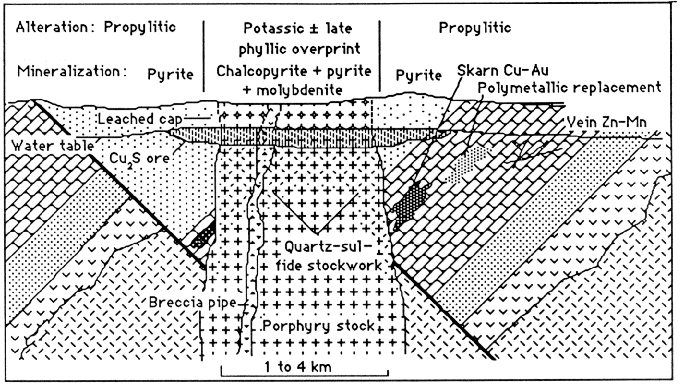
DESCRIPTIVE MODEL OF PORPHYRY Cu
MODEL 17
By Dennis P. Cox
DESCRIPTION This generalized model includes various subtypes all of which contain chalcopyrite in stockwork veinlets in hydrothermally altered porphry and adjacent country rock (see fig. 50).
Figure 50. Cartoon cross section illustrating generalized model for porphyry Cu deposits showing relation of ore minerals, alteration zoning, supergene enrichment, and associated skarn, replacement, and vein deposits.

GENERAL REFERENCE Titley (1982).
GEOLOGICAL ENVIRONMENT
Rock Types Tonalite to monzogranite or syenitic porphyry intruding granitic, volcanic, calcareous sedimentary, and other rocks.
Textures Porphyry has closely spaced phenocrysts and microaplitic quartz-feldspar groundmass.
Age Range Mainly Mesozoic and Cenozoic, but may be any age.
Depositional Environment High-level intrusive rocks contemporaneous with abundant dikes, breccia pipes, faults. Also cupolas of batholiths.
Tectonic Setting(s) Rift zones contemporaneous with Andean or island-arc volcanism along convergent plate boundaries. Uplift and erosion to expose subvolcanic rocks.
Associated Deposit Types Base-metal skarn, epithermal veins, polymetallic replacement, volcanic hosted massive replacement. See also: Porphyry Cu-skarn related, porphyry Cu-Mo, and porphyry Cu-Au.
DEPOSIT DESCRIPTION
Mineralogy Chalcopyrite + pyrite ± molybdenite; chalcopyrite + magnetite ± bornite ± Cu; assemblages may be superposed. Quartz + K-feldspar + biotite + anhydrite; quartz + sericite + clay minerals. Late veins of enargite, tetrahedrite, galena, sphalerite, and barite in some deposits.
Texture/Structure Stockwork veinlets and disseminated sulfide grains.
Alteration From bottom, innermost zones outward: sodic-calcic, potassic, phyllic, and argillic to propylitic. High-alumina alteration in upper part of some deposits. See table 3. Propylitic or phyllic alteration may overprint early potassic assemblage.
Ore Controls Stockwork veins in porphyry, along porphyry contact, and in favorable country rocks such as carbonate rocks, mafic igneous rocks, and older granitic plutons.
Weathering Green and blue Cu carbonates and silicates in weathered outcrops, or where leaching is intense, barren outcrops remain after Cu is leached, transported downward, and deposited as secondary sulfides at water table or paleowater table. Fractures in leached outcrops are coated with hematitic limonite having bright red streak. Deposits of secondary sulfides contain chalcocite and other Cu2S minerals replacing pyrite and chalcopyrite. Residual soils overlying deposits may contain anomalous amounts of rutile.
Geochemical Signature Cu + Mo + Au + Ag + W + B + Sr center, Pb, Zn, Au, As, Sb, Se, Te, Mn, Co, Ba, and Rb outer. Locally Bi and Sn form most distal anomalies. High S in all zones. Some deposits have weak U anomalies.
EXAMPLES
Bingham, USUT (Lanier and others, 1978)
San Manuel, USAZ (Lowell and Guilbert, 1970)
El Salvador, CILE (Gustafson and Hunt, 1975)